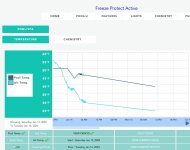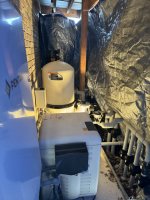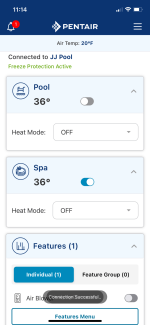- May 3, 2007
- 18,076
- Pool Size
- 20000
- Surface
- Plaster
- Chlorine
- Salt Water Generator
- SWG Type
- Hayward Aqua Rite (T-15)
There are a lot of factors for when a pool will start to freeze over so it is not a simple analysis.
To cool ALL the water to 32F and assuming that it is circulating so more less even throughout, you would need to remove about 2.5m BTUs. There are 4 ways to lose heat. Evaporation, convection, radiation and conduction and these depend on a lot of factors (i.e. latitude, air temperatures, dew point temperatures, wind speed, cloud cover, pool shell construction, pool cover).
But again, water does not freeze as soon as it hits 32F. The latent heat must be removed which is another 171M BTUs but that is for the entire pool to freeze solid which does not happen all at once.
So while it theoretically could be possible to calculate when a pool would start to freeze over, practically, you would need to know a lot of information (more than just air temps) about the future weather conditions which makes it very difficult to predict.
However, I have a spreadsheet that might get you close. I put in some numbers (see lines 26-40) and came up with the first 24hr loss of around 13F to 35F . So not too long. But again, I had to make a LOT of assumptions that may not correct.

 docs.google.com
docs.google.com
To cool ALL the water to 32F and assuming that it is circulating so more less even throughout, you would need to remove about 2.5m BTUs. There are 4 ways to lose heat. Evaporation, convection, radiation and conduction and these depend on a lot of factors (i.e. latitude, air temperatures, dew point temperatures, wind speed, cloud cover, pool shell construction, pool cover).
But again, water does not freeze as soon as it hits 32F. The latent heat must be removed which is another 171M BTUs but that is for the entire pool to freeze solid which does not happen all at once.
So while it theoretically could be possible to calculate when a pool would start to freeze over, practically, you would need to know a lot of information (more than just air temps) about the future weather conditions which makes it very difficult to predict.
However, I have a spreadsheet that might get you close. I put in some numbers (see lines 26-40) and came up with the first 24hr loss of around 13F to 35F . So not too long. But again, I had to make a LOT of assumptions that may not correct.





